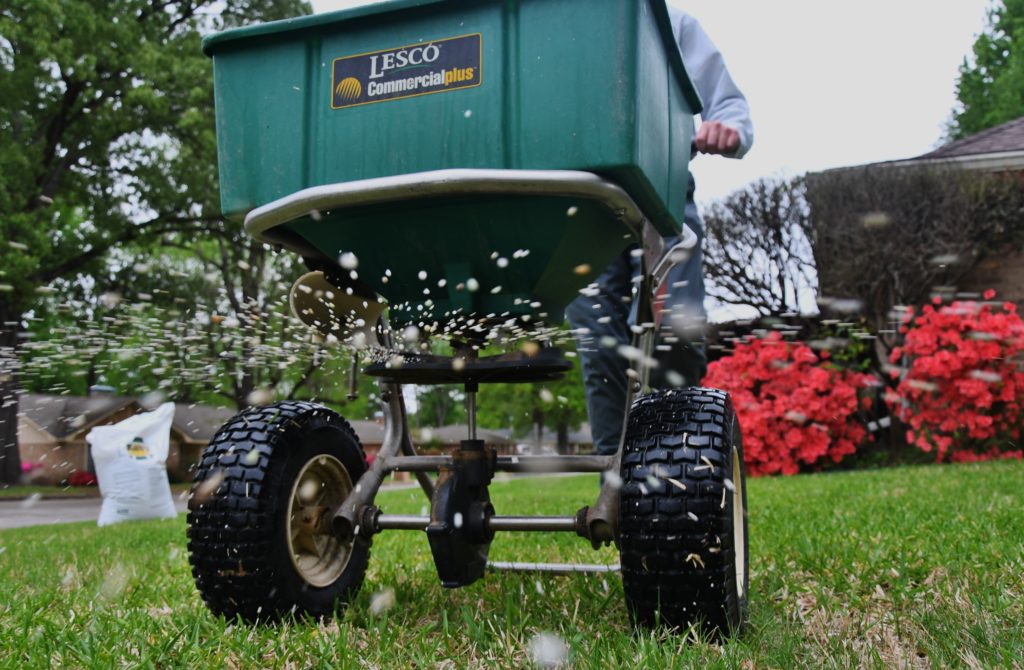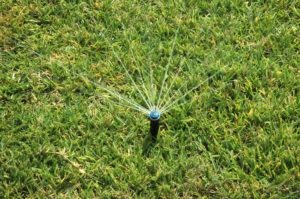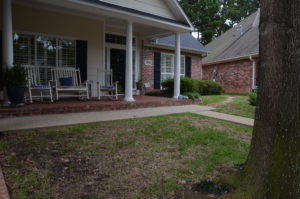Fall lawncare can improve spring, summer turfgrass

- Writer: Adam Russell, 903-834-6191, [email protected]
- Contact: Becky Grubbs, 979-845-0603, [email protected]
Homeowners can prepare their lawns for winter dormancy and set turfgrasses up for a good spring and summer now, according to a Texas A&M AgriLife Extension Service expert.
Becky Grubbs, Ph.D., AgriLife Extension turfgrass specialist, College Station, said lawns are about to enter dormancy throughout much of the state, and a few fall maintenance measures will set grass up for a strong spring reemergence next year.
“It’s typically best to perform some of these practices a little earlier, but it’s not too late for some regions of the state because we’re still experiencing warmer temperatures than usual,” she said. “But the window is closing, so now is the time to take action on your lawns.”
Fertilizer
Grubbs said this time of year, many homeowners have questions about winterizing their lawns, and there can be a lot of confusing or conflicting information on the topic.
“The purpose of late summer and early fall fertilizer applications is to provide your turf with sufficient nutrients and resources to prepare for dormancy and reemergence next spring,” she said. “There is research to indicate turfgrass utilizes nutrient reserves from the previous year for early season growth, but that does not mean homeowners should be putting heavy nitrogen applications on their lawns throughout the fall.”
Grubbs said both nitrogen and potassium can be beneficial when applied in the late-summer and early fall.
“Potassium has been identified as an important nutrient in turfgrass stress tolerance,” Grubbs explained. “These benefits can vary some depending on the unique situation, but for late-season fertilizer applications we often recommend a product that has both potassium and nitrogen in it. But timing is very important, and Texas is a big state, so the timing will vary depending on where you are.”
Generally, AgriLife Extension recommends the absolute latest fall fertilizer application should be made six weeks before the location’s historic first-frost date, she said.
“What this means is that much of the state does not need to apply any nitrogen-based fertilizers past September, but there can be some exceptions for more southern regions of the state,” she said.
Grubbs said there can be several consequences of applying too much nitrogen too late in the fall, including extended vegetative growth and ultimately winter kill.
“Too much nitrogen will encourage succulent, leafy green growth that is more vulnerable when we get a frost,” she said. “In the late summer and early fall, our goal is just to provide that last bit of sustenance for the grass to store through winter so it can be ready in spring.”
Too much late-fall nitrogen can also promote weeds and disease, Grubbs said.
Large patch disease, a fungus, becomes active as soil temperatures drop, and the disease proliferates when moisture and heavy nitrogen levels are present. Heavy amounts of nitrogen also provide energy to winter annual and perennial weeds.
For homeowners who may have already missed their window this year, Grubbs says there are some other steps they can take to be proactive with their nutrient management.
“This can be a good time of year to test your soil,” Grubbs said. “Collecting soil samples and having them analyzed now will help you design an appropriate nutrient management plan for next year.”
Irrigation
Fall is a time when homeowners should put an end to automated irrigation, Grubbs said. Grass needs far less water as it nears dormancy.

“If you water at all, just do so based on visible wilt until growth is suspended,” she said. “Then, if there is no active growth or grasses go dormant, you should stop watering completely. This season has been warmer and drier than usual, so it all depends on the location and conditions.”
Suspension of watering is typical between October and April for much of the state, Grubbs said.
Weeds
Fall is when many of our winter weeds such as lawn burweed or annual bluegrass will start to emerge, and it is not too late to take preventative action by making a fall preemergence herbicide application.
Preemergence herbicides to combat winter annuals like lawn burweed can be applied now, she said.
“We typically want to apply when soil temperatures reach approximately 70 degrees,” she said. “That’s often around the time when you have four to five consecutive days of 60-65-degree nighttime temperatures consistently. If you haven’t gotten your preemergent out yet this year, there may still be time as we had one of the hottest and driest Septembers on record.”
Grubbs recommends homeowners select products that are exclusively herbicides for this purpose.
Products may not be clearly marked as “preemergents” but may instead have language on them such as “weed preventer.” So, being familiar with some of the active ingredients can be helpful, she said.
“Common active ingredients used for preemergence control include prodiamine, dithiopyr, pendimethalin, isoxaben and others,” she said. “You can find these by themselves or in combination with postemergence herbicides for weeds that have already germinated.”
Finally, Grubbs said homeowners should always take time to read and follow product labels.
“These products will have specifications on appropriate application rates and timings in order to be more effective,” she said. “It’s very important homeowners take time to do their research and follow all label instructions in order to both get the most out of their product and reduce any potential risk to their lawn and other landscape plants.”
Fall armyworms
Fall armyworms are typically an insect pest forage producers monitor to reduce grazing or hay production losses, but Grubbs said the pest can also negatively impact turfgrass this time of year.
Homeowners should monitor their yards for armyworms up to the first frost, she said. They can be voracious consumers and should be treated quickly.
“Homeowners should keep an eye out for them, especially on newly planted areas,” she said. “They can feed on vegetation down to the soil. While they generally do not kill our warm-season grasses, they can create exposed areas, which allow weeds and other problems to move in.”
Disease
As temperatures begin to drop in the fall, select turfgrass diseases will become more active. Grubbs said many practices already discussed here, including reduced irrigation and nitrogen-based fertilization in the fall will help prevent disease problems.

But other important cultural practices, including improving drainage as-needed, annual tree pruning to increase filtered light and mowing at an appropriate height, can reduce disease risks.
“Diseases will often proliferate in areas where some sort of stress is already occurring either from shade, poor drainage or scalping from mowing too low,” Grubbs emphasized. “When homeowners take steps to reduce these stresses, they are less likely to have issues with many of these diseases.”
Grubbs said chemical prevention is also an option where homeowners have had historic issues with diseases such as large patch and take-all root rot.
“In lawns with a known history of disease, we sometimes recommend a preventative fungicide application in the fall around the same time we apply our preemergence herbicides.” Grubbs said. “Fungicides can be expensive, so it can be helpful to note where disease issues tend to recur so you can be more precise with your applications.”
Grubbs stressed that proper diagnosis is key when designing any chemical management plan.
“Misdiagnosis is not uncommon in the case of many of our pest and disease issues,” she said. “In order for our management programs to really be effective, it can be good to get your AgriLife Extension office involved when there is a question of proper identification of any turfgrass pest or disease. This will help you both with treatment and prevention.”


